Considering the wonderful coverage Curt here at Urban Indy provided in the months leading up to and during the construction of the Broad Ripple Parking Garage, it’s surprising that nobody wrote a feature once it opened. But it looks like we didn’t.  So here’s a chance, now that the garage has just celebrated its fourth birthday.
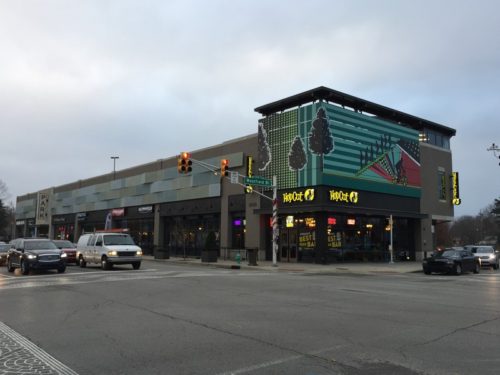
People in the local blogosphere routinely rant and rave about how many development projects have depended upon taxpayer subsidies to get off the ground—either in the form of liberal application of Tax Increment Financing, reduced-interest loans, or even direct subsidies. The argument seems to stretch across both ends of the political spectrum, and in this era of violent political divide, it’s a common practice that doesn’t seem to yield such powerful partisan split. Whether we laud the Keynesian approach or lament the average private developer’s dependency on handouts, the practice inevitably has altered the physical form of Indianapolis, particularly in older urban neighborhoods for which years had passed without much empirical evidence of new construction.
Among the most controversial of these beneficiaries has been the developer of the aforementioned parking garage at Broad Ripple and College Avenues. The City of Indianapolis contracted with Keystone Consulting Group to build a 328-space garage, consisting of two floors of parking stacked atop ground-floor retail, which opened to the public in April 2014. An inquiring mind might ask, “Why did the City initiate a contract for this?†The answer is simple: the City paid for a huge portion of it. More than one third, in fact. The $15M structure received a $6.35M subsidy—part of the $20M the City raised overnight when it sold its parking meters to a private company several years ago.
The construction of the garage and its developer/current owner, Keystone Construction and Keystone Realty respectively (under one CEO), no doubt reaped the benefit of this subsidy. And while I currently work for a cost estimation firm, as of yet I know little to nothing about the practice myself, so I’m going to withhold judgment on the appropriateness of the $15 million price tag. At the very least, I can credit the design team for working with the city to integrate retail, which would have otherwise demoted a lackluster land use to a block-long blank wall in the city’s historically strongest entertainment district. Also, the team also integrated decorative features along the wall fronting College Avenue, as well as an art installation at the intersection, thereby making the garage more aesthetically pleasing than most Indy parking garages (albeit a painfully low bar). And, without a doubt, the garage is an improvement over what sat there before: a long vacant gas station and an unadorned, freestanding fast food restaurant. The presence of a dormant gas station new doubt spawned brownfield-like conditions that at least in part contributed to the hefty eight-figure price tag. So, that leaves three gold stars for Keystone.
But no one—not even the owner—can deny that the garage’s early days have been fraught. The retail space absorbed slowly—very slowly—a condition no doubt amplified by the fact that, six months after opening, most metrics show that the garage’s average vacancy languished at a staggering 95%. Even at the times of Broad Ripple’s peak nightlife—11pm on weekends—it generally only achieved about 20% occupancy. Additionally, the reports of extensive interior ponding suggest some serious civil engineering deficiencies, while the inadequate size of the signage constituted a code violation, while undermining its nighttime visibility.
As time passed, conditions at the Broad Ripple garage failed to improve. At least two tenants (Firehouse Subs and Orange Leaf Yogurt) elected not to renew their leases. After a year in operation, the management lowered the rate of the garage from $2 for the first hour to $1, matching the rate of parking meters in the area. Obvious translation: the garage was failing to compete with on-street parking, and the absence of any organized effort among the Broad Ripple Neighborhood Association to develop a residential parking permit arrangement certainly didn’t help. The garage’s fate took a more positive turn a few months later, when Grand Rapids-based beer bar HopCat opened in the largest retail space. The apparent success of HopCat seems to have improved the occupancy rate for the retail, but problems linger. More recently, Keystone partnered with Enterprise Rent-A-Car to propose a small operation on the top floor, featuring a small office, car wash and the use of 20 spaces. Yet again, this initiative reveals that the owner is stretching further to generate more revenue out of the garage. Finally, an Indy Eleven Team Store opened recently in a remaining vacant retail slot. While this may seem inconsequential, the CEO of Keystone is also owner of the Eleven, the Indianapolis division of the North American Soccer League. In other words, the CEO of Keystone is spinning off some of his own equity to help pay off construction loans for the garage—loans that the City already helped reduce by over 6 million.
During my last visit to Indy over the holidays, I made a visit to the garage and tried it out.
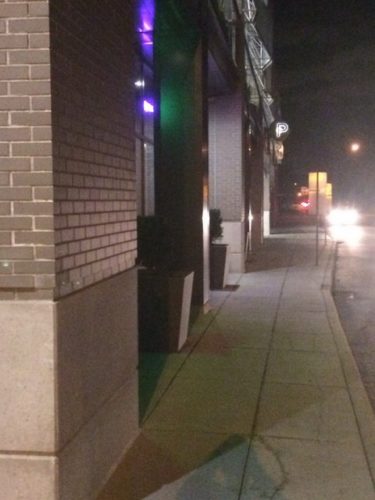
It features two entrances: one on College Avenue and one on Westfield Boulevard. I took the latter.
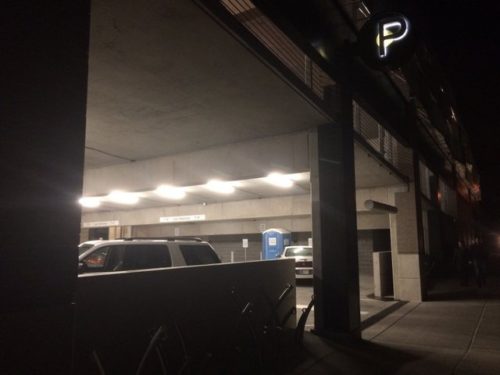
Upon entering from Westfield, the motorist faces an intersection, which instructs him or her to stop, deferring traffic flow to those who entered from College Avenue. Here’s what it looks like from the second level, peering downward over a railing. The two or three parking spaces visible in this photo are reserved for employees of retail within the garage.

No big deal, right? Well, check out that right-hand turn.

It may not be clear, but it essentially requires a vehicle to make a turn less than 40 degrees. Maybe even 35. It’s like being positioned at 6 o’clock and being forced to point yourself at 4 o’clock. My Subaru Legacy may not have the world’s greatest turn radius, but I suspect it’s at least above average, given the American fondness for cars much bigger than a Legacy. And I couldn’t make it. I had to complete a three-point turn, backing and re-positioning myself. Even better: this stop occurs before the ticket gate.
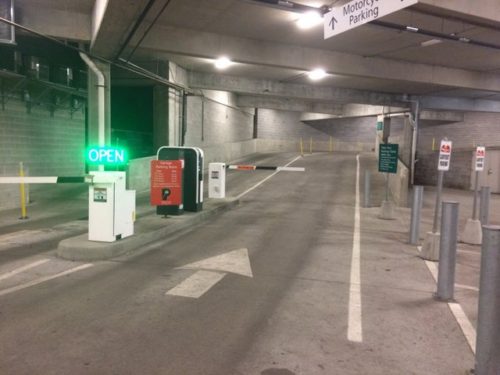
In other words, if, on that rare occasion, the garage experience a backup of cars trying to enter at the chokepoint induced by the ticket gate, virtually every car at this intersection will misjudge, forcing it to back up and shift its tires to manage that ridiculously sharp angle. It could cause a chain reaction of cars getting forced into reverse.
In other words, it’s a pain in the ass.
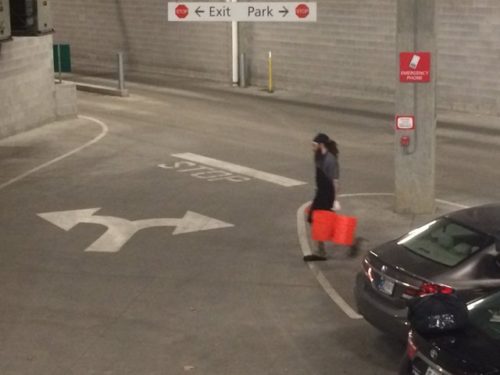
The gentleman in the photo below, an employee at one of the garage’s storefronts, confirmed it for me: virtually everyone has to back up to clear that right-hand turn. Fortunately, even with HopCat in full swing, the odds of a backup are slim. Here’s what the first level of parking looked like during peak dining time on a weekend night.
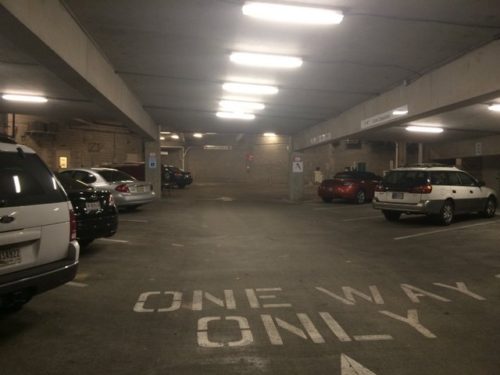
Not only is the Broad Ripple Parking Garage an underperforming piece of real estate, it isn’t even user-friendly. At least some drivers are likely to warn others, and while this critical design flaw may not exclusively explain the garage’s low usage, it certainly doesn’t help the situation.
It goes without saying that the garage is a white elephant for the City—possibly one of the biggest black eyes for the Ballard administration, an eight-year period relatively free of controversy (and if you disagree with that statement, I invite you to survey the journalistic landscape of mayoral leadership in just about any other city of Indy’s size). But the evidence this blog has gathered suggests that it has turned into an burden for the owner as well. Some might argue this is justice for Keystone. After all, the CEO probably did enough of a market analysis to determine that he couldn’t guarantee a return on the investment based on cost estimates, including remediation for soil contamination…so he cajoled the City to pony up a huge portion, in an effort to meet a vague need (parking demand in Broad Ripple) that a far less elaborate project might have satisfied. If he hadn’t received this generous subsidy, would he have sunk all his money into such a poor design? If he had sought a market-driven method of adding vibrancy to a key intersection in Broad Ripple, wouldn’t a mixed-use product with housing or offices on a few upper floors have helped the retail? After all, retail follows rooftops, and the lack of any fixed population may have eased traffic along narrow Westfield Boulevard, but it certainly limited the capitalization rate for this proposal.
I’m going to step away from flogging Keystone any further. It seems like the firm is already paying the price. And it may be the fault of the architect or another engineering subcontractor. More critical is that this development manifests a failed synergy within a public-private partnership. Both parties blundered. They just didn’t think it all the way through. And, because neither side had as much at stake, the vision got flabby, watered-down and complacent. The alliance of equity partners could have instilled a system of checks and balances, where each affiliate imparts the best of its expertise into the design and planning, since they all have something to lose if it tanks. The outcome in this case almost inevitably suggests a certain degree of palm-greasing along the way, which, though not necessarily unlawful, certainly evokes a lack of transparency. Other potential equity partners were too savvy to partner with Keystone on a product of dubious demand. But not the City! The benighted public sector can make as many poorly conceived decisions as it wants and it will never go out of business.
Maybe someday land values in Broad Ripple will increase enough to encourage redevelopment on the site of the parking garage—a fanciful prospect that a good transit system (Red Line?) could easily expedite. But regardless of what this albatross looks like in a decade, the fact remains that, in the words of James Murphy, Yr City’s a Sucker, and Indy taxpayers lost out on a chance of a wise public investment to the tune of $6.5 million.
I’m coming at this from the Average Person’s perspective, but I’ve never felt the need to use this garage the few times I visit Broad Ripple. I can usually find on-street parking pretty easily or the big parking lot just east of the Monon Trail. Until Hopcat opened up I never felt a need to visit any of those particular shops on the first floor.
About the only reason I could think of where I would want to park in that garage is if I were attending a concert at The Vogue. Parking right across the street is easy to get to after a concert. Yet I don’t attend many concerts there.
Just Mk I eyeballing this situation the only reason I can think of where this garage would be used more often would be if the homeowners in Broad Ripple instituted a parking sticker policy for on-street parking.
On the plus side as parking garages go this is one of the nicest ones I’ve ever seen from the outside.
Perhaps the biggest benefit of the garage is removing/rebutting the common perception that “there is no parking in Broad Ripple.” Thanks to the garage, I hear this argument much less frequently.
As for Ballard administration black eyes, the parking meter deal remains the biggest black eye by far.
The Parking Meter Deal was indeed insane. The city said: “we need to raise meter rates, but it’s politically toxic. Let’s outsource that to a single-bid contract, have them raise the rates, and yet get next to zero benefit for the city from the deal.”
You all know far more about the details behind that deal than I do, but it does seem from pretty godawful from the perspective of someone who wasn’t living in Indy at the time. Even worse: nearly one-third of the meager amount gained by selling these rights went to subsidize the garage we’re ranting against right here and now.
It’s one of those things that makes me shake my head every time I park at a meter. My wife said it best: At least in the past, you knew the money was going to the city. Now it’s going to a corporation in Dallas.
Chicago took a similar deal and encountered all kinds of problems. Indy’s deal failed to resolve the 5 or 6 main problems encountered by Chicago and had even worse terms.
It remains the most single inexcusable thing Ballard accomplished.
This is an excellent discussion of the issues involved with Indy’s parking meter lease deal details: http://www.urbanophile.com/2010/09/07/indys-son-of-chicago-parking-meter-lease-to-be-a-disaster-for-city/
Great article Eric. I guess Curt and I and others can say “I told you so” on this one (not to you obviously!). At least I can say that I tried to give an alternative solution.
I’ve always been very disappointed in this garage, as it could have actually done some good for the community had it been implemented as part of a larger strategy. The addition of a parking pass program for on-street parking in the residential area and removal of on-street parking along 62nd (therefore allowing the insanely narrow sidewalks to be widened) would have been of substantial benefit. Granted, the heinous parking deal the city made makes the removal of on-street parking on 62nd borderline impossible.
I used to live at Kessler & Winthrop. Just far enough from the strip to not have visitors streaking our street parking. Right before we left that house in 2013, BRVA was doing a house-to-house survey to assess if permit parking in the area would be something residents would go for. Obviously neighbors were anti permit.
I have used the parking garage numerous times (always entering from the southbound lane of College Avenue) and like its convenience. There have been more than a few times when the garage has been more full than this atticle describes. As Broad Ripple evolves, and as attitudes inevitably shift from a “free parking” mentality the garage will be more popular among those who choose to drive to the Village.
The 20% occupancy is an average for peak times (i.e., weekend nights). So obviously there will be times when it is better than that. But a 20% average is still abysmal. A garage owner with those levels is going to have to go to extreme levels to either generate more revenue or keep operating costs down. Generally the first show to drop is maintenance and upkeep. I don’t want to sound cynical, but unless things radically change, I’d be very surprised if this garage isn’t a serious eyesore within 5-10 years.
I lived in three different places within walking/biking distance from the Village for many years (before the garage, before the Monon, and even going back to the old days of the parking deck over the Canal, removed 1999) and never really had any trouble finding parking in the Village.
Now that I live on the other side of town, the one place where I know I can find parking without looking too hard is…this garage. The last time my wife and I went to dinner at Brugge we parked here and walked through the village.
(Note that “the big lot” by Thr33 Wise Men is technically private and you can be towed if not visiting one of the businesses in the strip mall or Scotty’s. It was never a problem for me as I owned a business there back in the day…except on BRHS graduation day.)
I figured the big strip mall lot was private and at least somewhat regulated at night. Do they tow enough to intimidate people from parking as freeloaders? What about parking at the Coil, especially weekend nights, when demand for grocery parking would be low?
WRT to the strip mall lot, it’s actually divided at the pylon sign. West of the sign, and north of the Scotty’s building extended east, is Scotty’s lot. The rest is the strip mall, and they have separate owners. I don’t know if they have joint enforcement, or any enforcement. They used to be a little slack, but did tow back when Scotty’s location was Sunflower Market.
I haven’t been close enough to the Coil to see whether there is “public” parking available, and how much it might cost. The competitive Fresh Market a mile south has free surface and structured parking.
Back when I still lived nearby, the BR Kroger lot had a pay station on weekend nights, but they’d let you skate if you were going to Kroger before it closed.
For quick trips I prefer to park on-street. Garages are generally more expensive and take more time to use.
One (possible) positive about this. I have been to a couple of development meetings where a new office building being constructed plans to lease spots in the garage (only on an as needed basis). This could provide a flexible amount of parking for new office type businesses in the area.
The deed is done and it could take a cost burden off of developing a small scale office building on a tight site.
Not only office but also a small restaurant or shop. It should be easy to get a variance from required parking.
In addition to the former administration’s black eye on the parking meter contract was the Blue Indy debacle. Maybe a novel idea but terribly financed and executed. And, the City and IPL attempted to foist costs on IPL ratepayers (not taxpayers) to pay for the infrastructure, in contravention to state laws.
Great analysis — I no longer live in Indy, but was a resident of the area (Meridian Kessler) for 15 years, and so I remain interested in things political and policy-related. I agree with the sentiments that this was one of the worst deals (among many) of the Ballard administration, and just wish that there was some way to punish those responsible for this misuse of public authority (and for the stupid parking meter deal as well)
It’s really sad that for the $5 or $6 million the city taxpayers invested, the only positive thing that can be said is that griping that there is no parking in Broad Ripple is down.
What a squandered opportunity!
I have never used this garage, people complain about parking because they don’t want to walk and probably assumed that building a garage would make some people park there and free up spaces closer to the businesses whiners want to attend. Even on the busiest night I can always find parking in broadripple.
Sorry to be so late to the commenting party but I really needed to take a step back and digest Eric’s report as well as the comments before weighing in. I was very involved in this project from its inception and I maintain that while not perfect, the parking garage has been successful in a number of ways.
Let’s take Eric’s spot-on observation about the tight right-hand turn. The community lobbied very, very, very hard to place the College Ave. entrance on the far south side of the building. The developer, however, countered with the current design because he was holding out for a drive-thru window for a bank tenant in the southern-most space, hence the placement of the College Ave. entrance as it stands. The tenant never materialized so we were stuck with the design. Had we been successful in placing the entrance further to the south, I can’t guarantee that the turn Eric identifies would have been improved but it could have led to more conversations that could have improved access. This point is worth highlighting: Keystone was very engaged with the community during the design and construction of the garage and while we certainly didn’t get everything we wanted (e.g. I wanted 18 foot wide sidewalks on the Collage Ave. side) I felt that they dealt with us in good faith. They have remained in steady contact with the community, too, which is much more than can be said about many Broad Ripple property owners.
Further, the neighborhood did not want traffic to exit onto Westfield, hence the entrance-only off of Westfield which may have contributed to this internal traffic pinch point.
Eric acknowledges that he didn’t live here during the many public conversations about this project. So some context is in order. It was a period of “non-consensual towing” (including, but not limited to, the strip mall parking lot on BRAVE) which provided lurid headlines in local media and sent out the message “Don’t come to Broad Ripple!” Assaults, robberies, car break-ins, and even some shootings were also highlighted by the media and fed the “stay clear of Broad Ripple” meme. Many of these crimes occurred in the residential neighborhoods south of BRAVE late at night/early in the a.m. when patrons of local establishments returned to their cars. While we love our mature street trees, in summer they manage to block the few auto-oriented streetlights (as opposed to ped-scale lighting) in the neighborhoods, creating perfect habitats for predators to pick off stragglers from the herd.
Together with the Ballard administration and our City-County reps, Broad Ripple saw a well-lit, centrally-located parking garage as an attractive alternative. In fact, the Village had been clamoring for one for decades as parking variance piled upon parking variance and high occupancy establishments with insufficient on-site or on-street parking opened to great acclaim.
When the Ballard Administration offered to subsidize the long-desired garage with funds from the upfront payment the City got for the parking meter lease, it sounded like a good deal. State law holds such revenues should be spent in the areas in which they were generated and Broad Ripple felt the investment was long overdue. Parking meters were installed in the Village in 1957 and the community was hard-pressed to find any evidence that funds had been reinvested in the Village. Here was our chance. NOTE: past parking studies had recommended a parking garage. The Village community insisted that the new project be mixed-use which added a certain degree of difficulty in financing and constructing in this market where mixed-use structures were far from the norm.
The City sent out a Request for Proposals and of those, the one at College & Westfield seemed the best way to capture automobile traffic at the edge of the Village on arterials, get pedestrians on the street and limit traffic in the neighborhoods. FYI: the owners of the parking lot behind the Vogue did NOT submit a proposal. One was the Kroger/Kilroy’s property, another at Westfield & Winthrop, another on Winthrop @ 61st and one where the COIL is now located. Each requested subsidy. The Keystone bid required the least.
Part of the attractiveness of the Keystone bid was the location (a long-abandonded Marathon station that the oil company had zero interest in selling except for top dollar, and a decrepit former Rosslyn’s bakery that had multiple curb cuts creating poor pedestrian access.) Keystone’s bid offered to place an art element at it’s own (not inconsiderable) expense on the façade at the main intersection as well as a mural on the rear of the property facing the alley – both attractive in concept to the only Cultural District outside of Downtown. The offer of rent-free space to IMPD for a decade also sweetened the deal. (The office houses the cops-on-bikes office/repair/storage room.) A heightened IMPD presence (even if one couldn’t file a police report there) was considered another benefit to the community as bike patrols have proven to be a super-effective law enforcement tool in the Village (and elsewhere.)
Drainage is a huge issue in Indy and certainly at this key intersection. As part of the construction project, Keystone installed Aqua Swirls (a kind of powered cistern that captures water during a rain event, removes particulates and feeds the water back into the stormwater system at off-peak times.) NOTE: While this has helped the west side, the east side of College still floods.
Additional infrastructure improvements on the site reduced the number of curb cuts from 6 to 2 which creates a more pedestrian-friendly environment, a goal of the Envision Broad Ripple Plan. Previously there had been poor, narrow sidewalks and now there are sidewalks approaching 10 feet wide in places. And the intersection has been formalized with decorative crosswalks, pedestrian crossing buttons for traffic signals and the removal across the street of the traffic signal box (which previously had blocked the sidewalk and which now also sports some black and white monster art.) Oh yeah, and Keystone installed bike racks, street trees and planters at the community’s insistence. (NOTE: This was well before Indy Rezone mandated such elements so they were at the developer’s discretion.)
For me, and for many in the community, the mixed-use parking structure was always designed to be more than a car barn. Yes, there’s a high-occupancy bar and the outdoor seating takes up valuable real estate in the public ROW. However, Keystone held out for months and I’ve been told turned down potential tenants that would not have been as good of a contribution to the Village’s hospitality industry as Hop Cat has been. Today, on any given night, there is a vitality and liveliness to that corner like never before and that has had a positive stimulating effect on Village place-making, street life and urban vitality.
Here’s where I think the Garage’s greatest success lies. With its inclusion in the Tax Increment Finance district (AKA Midtown TIF) the property tax increment it generates enabled construction of the COIL, which, in turn, helped partially fund the Canal Esplanade AND Tarkington Park improvements. Broad Ripple has been working for 30 years to make the Canal look like something better than a drainage ditch and four neighborhoods have been working 20+ years on aspirations for Tarkington Park. Given the constrained fiscal reality of the City’s budget: no garage, no public improvements. It’s that simple.
Construction of the Broad Ripple Parking Garage sent a signal to the development community – and to the City – that Broad Ripple is a place worth investing in. Look at what’s in the pipeline: 100+ apartments at Park 66 Flats (near Opti-Park), retail, office and residences at River House (across from Brugge), mixed-use office and retail in the 1002 building, 130 apartments & retail in The Line (former Rogers Pool), Buckingham’s Monon Place Phase 2 at the former McNamara’s Florist building and more. All told, $60M+ of investment in Broad Ripple that brings with it infrastructure improvements like sidewalks, sewers, pedestrian scale lighting AND increased population and daytime activity – all of which are desired outcomes embedded in the Envision Broad Ripple Plan. The Parking Garage was the catalyst that spurred this all to occur.
I do not deny the quibbles about tenant mix and considerations of parking utilization (which has taken longer than anticipated but I’m told is steadily increasing.) Paul’s comment above is true: projects in the Village are receiving parking variances because of proximity to the Parking Garage. This helps preserve the Village public realm in our 1840s ROW, encourages more bike/pedestrian traffic and places automobiles in proper perspective which preserves the Village “look and feel” that some feel is under threat.
Parking in a reasonably-priced, safe, conveniently-located and well-lit garage with within a pleasant walk to work or breakfast/lunch/dinner or a show encapsulates the urban village life that Envision Broad Ripple seeks to foster. The planned placement of the Red Line EBRT station at the intersection will further add to the multi-modal vitality of the Village and the garage’s potential park-and-ride utility.
I appreciate Eric’s observations but question his statement that the parking garage was a squandered opportunity. If a $6.35M investment stimulating nearly $100M in additional development and public realm improvements is “squandered,” I’m obliged to question your metrics.
“The Parking Garage was the catalyst that spurred this all to occur.”
Yet the parking garage is an abject failure. BR didn’t need all of that office space and apartments, etc. And it certainly didn’t need a Fresh Market (Sunflower Market failure anyone?). The final nail in the coffin for me personally was them turning Broad Ripple Ave. into one lane both ways, which basically makes it complete gridlock from College to Keystone any time of day. Broad Ripple isn’t improving with these “improvements”, it is languishing.
So by your metric, was Broad Ripple in much better shape when all these parcels were filled with surface parking lots?
Broad Ripple may be a lot of things today, but, considering that developers (whose best interest is to know the market) have been proposing multifamily residential projects at all sorts of different locations in the neighborhood these last few years, I’d say it is anything but languishing.
I apologise for attributing Joe’s “squandered” statement to Eric who did state taxpayers “lost out” on the chance of a “wise public investment.” I don’t agree.
One item missing from the discussion about cost to taxpayers is the provision in Keystone’s contract with the City that allows for additional payments from the City to Keystone to “buy down” the rate which users pay to park in the garage. It would be interesting to find out how much the City has paid Keystone per this provision.
I see you don’t monetize your website, don’t waste your traffic, you can earn additional bucks every month because you’ve got
high quality content. If you want to know how to make extra
money, search for: Ercannou’s essential tools best adsense alternative
As of May 11th, 2018, they now want to create a “Blvd” on Broad Ripple Ave. from College to Broad Ripple Park area. They want to eliminate the bike lanes and get rid of the median and create a 12 ft. wide path on the north side of the street. The street is already messed up and congested from them putting in the bike lanes and turning the street into one lane each way. The area keeps getting more and more messed up as they try to keep making improvements to it. BRA never should’ve been turned into one lane each way because it is way too busy of a street. I’m glad I no longer live in the area. And the parking garage is an abomination altogether.
A dedicated, large trail, protected from traffic would be a fantastic development. I hope it turns into reality. Obviously, Broad Ripple Ave does not need to be more than one lane in each direction – it’s a small area, and traffic flows are hardly congested. Getting rid of multiple lanes was the best thing they’ve done in a long time. Great news!
So here we are fast forwarded to December 2019. The Garage still is not preforming so they now tout that we need more density to make it work! Are you Kidding me….on Project built on the wrong assumptions or someone’s desire for a project only leads to another Project that will fail. Do it right the first time! Designe it right and address all of the Issues the project might bring from the start.
Residents take charge. It is your neighborhood